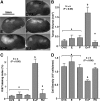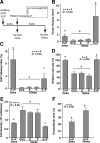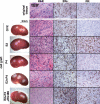Progesterone is essential for maintenance and growth of uterine leiomyoma
- PMID: 20375184
- PMCID: PMC2875812
- DOI: 10.1210/en.2009-1225
Progesterone is essential for maintenance and growth of uterine leiomyoma
Abstract
Uterine leiomyomata (ULs) represent the most common tumor in women and can cause abnormal uterine bleeding, large pelvic masses, and recurrent pregnancy loss. Although the dependency of UL growth on ovarian steroids is well established, the relative contributions of 17beta-estradiol and progesterone are yet to be clarified. Conventionally, estradiol has been considered the primary stimulus for UL growth, and studies with cell culture and animal models support this concept. In contrast, no research model has clearly demonstrated a requirement of progesterone in UL growth despite accumulating clinical evidence for the essential role of progesterone in this tumor. To elucidate the functions of ovarian steroids in UL, we established a xenograft model reflecting characteristics of these tumors by grafting human UL tissue beneath the renal capsule of immunodeficient mice. Leiomyoma xenografts increased in size in response to estradiol plus progesterone through cell proliferation and volume increase in cellular and extracellular components. The xenograft growth induced by estradiol plus progesterone was blocked by the antiprogestin RU486. Furthermore, the volume of established UL xenografts decreased significantly after progesterone withdrawal. Surprisingly, treatment with estradiol alone neither increased nor maintained the tumor size. Although not mitogenic by itself, estradiol induced expression of progesterone receptor and supported progesterone action on leiomyoma xenografts. Taken together, our findings define that volume maintenance and growth of human UL are progesterone dependent.
Figures







References
-
- Day Baird D, Dunson DB, Hill MC, Cousins D, Schectman JM 2003 High cumulative incidence of uterine leiomyoma in black and white women: ultrasound evidence. Am J Obstet Gynecol 188:100–107 - PubMed
-
- Parker WH 2007 Etiology, symptomatology, and diagnosis of uterine myomas. Fertil Steril 87:725–736 - PubMed
-
- Merrill RM 2008 Hysterectomy surveillance in the United States, 1997 through 2005. Med Sci Monit 14:CR24–CR31 - PubMed
-
- Shimomura Y, Matsuo H, Samoto T, Maruo T 1998 Up-regulation by progesterone of proliferating cell nuclear antigen and epidermal growth factor expression in human uterine leiomyoma. J Clin Endocrinol Metab 83:2192–2198 - PubMed
-
- Park SH, Ramachandran S, Kwon SH, Cha SD, Seo EW, Bae I, Cho C, Song DK 2008 Upregulation of ATP-sensitive potassium channels for estrogen-mediated cell proliferation in human uterine leiomyoma cells. Gynecol Endocrinol 24:250–256 - PubMed
Publication types
MeSH terms
Substances
Grants and funding
LinkOut - more resources
Full Text Sources
Other Literature Sources
Medical
Molecular Biology Databases
Research Materials

